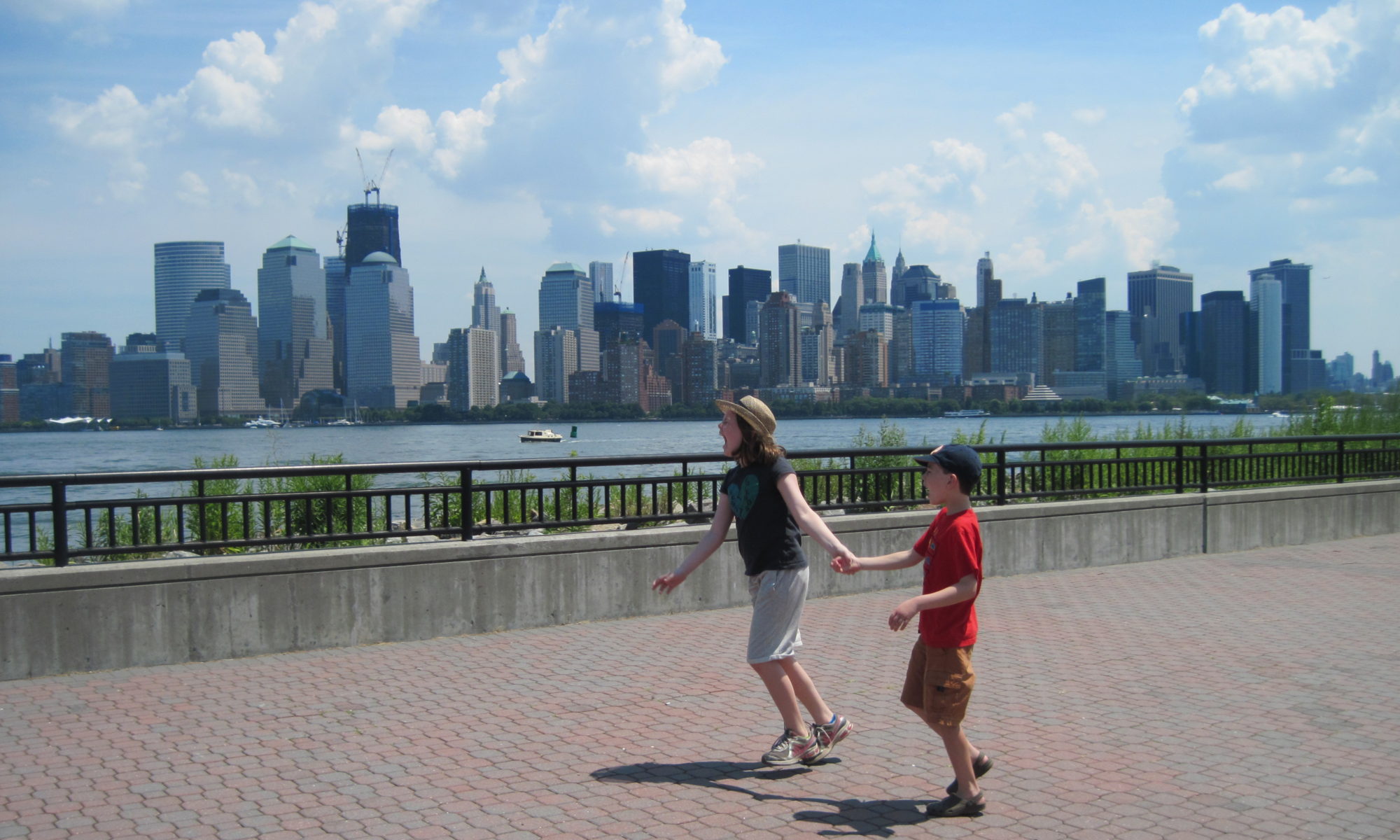The Edelman Fossil Museum & Park opened up March 29, in Mantua, NJ. Not just for kids, this museum will intrigue even adults (I know because I went alone to review it for Newsday – read my article here). That said, the museum did a great job making it accessible and interesting to all ages. The display information was aimed at earlier ages, but still had lots of intriguing education for those of us who aren’t in school anymore. I spent a long time reading all the placards.
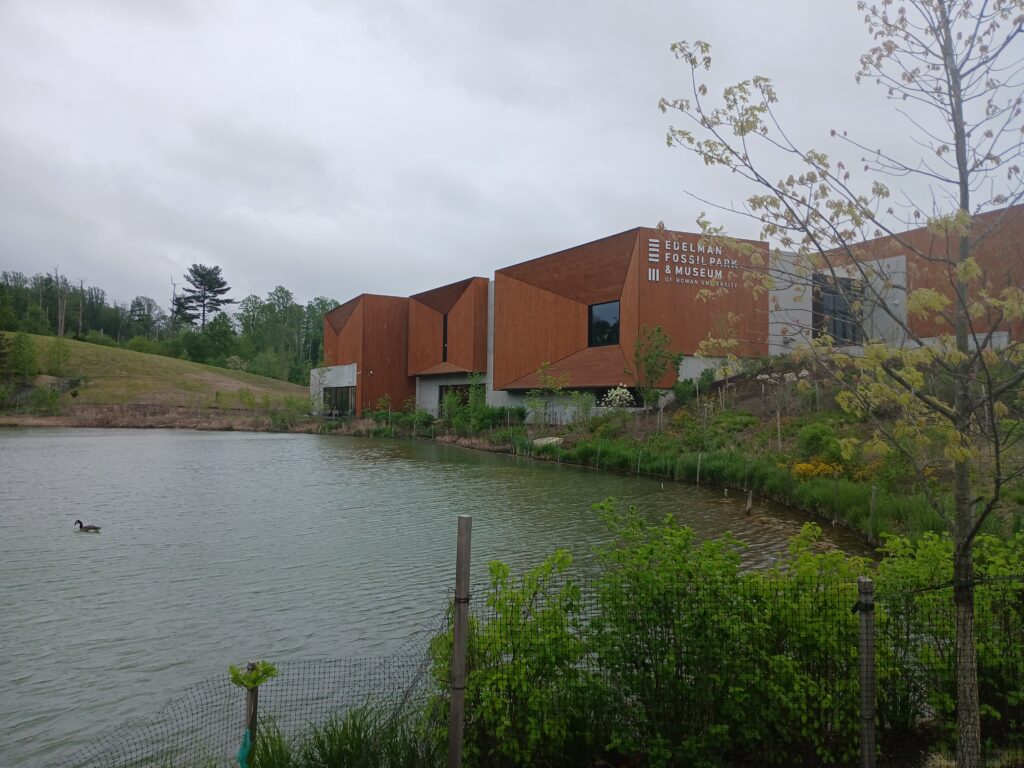
Turns out New Jersey is the perfect place to learn about fossils, thanks to a number of factors. First, the marl pits. Haven’t heard of marl? I hadn’t either. Marl is a sand-like substance that used to be mined and processed all over the state, used for fertilizer and filtration. It worked well for acidic-loving plants like tomatoes, cranberries and peppers, Nick Sena, the museum’s development director told me in an interview. Over time, the state regulations made it too expensive for the marl operators to continue, and the operations moved overseas.
The terrain is still pocketed with marl quarries. You might recognize the names Marlton and Marboro. Yes, named after marl operations in those areas. Fun fact for your next cocktail party!
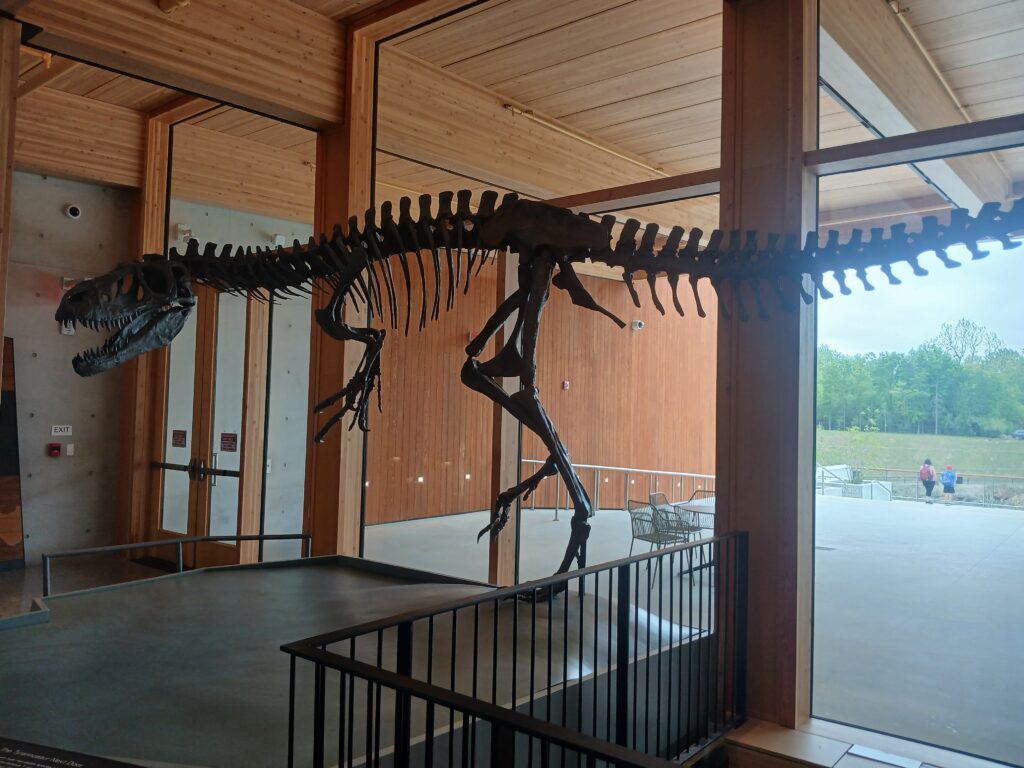
This specific location used to have marl operations run by the Inversand Company, and they discovered fossils – mostly marine – while digging. If you go about 40 feet below the surface anywhere in New Jersey, you’ll find fossils and bones. Inversand called in Dr. Kenneth Lacavera, then a paleontologist at Drexel (now at Rowan, and also the museum director), to do quick excavations in the off hours. Dr. Lacavera, colleagues and students spent a lot of time digging there, so much so that when Inversand wanted to sell, Dr. Lacavera tried to find funding to buy the property. Drexel said no, but Rowan University said yes. At the time, they didn’t know how significant the site was.
Specifically, one of the trustees, Jean Edelman and her husband Ric, agreed not only to Dr. Lacavera’s $300,000 request for funds to build a small welcome center on the property, but offered him $25 million towards a larger museum. With some additional fundraising and bond measures, the $75 million facility is now open.

As you’ll see from the sign toward the bottom of this post, lots of dinos were discovered not far from this Mantua site, including a duck-billed hadrosaur dug up in Haddonfield in 1858, 12 miles away. And a dryptosaur was discovered in 1866 – only 1 mile from Mantua. The models on display here were fashioned by the top dinosaur sculptor, Sena told me. There are also some skeletal recreations in the lobby (see the photos at the top).
While there are a lot of dinosaurs in the first few galleries, during this Cretaceous period 66 million years ago, New Jersey was actually underwater. And dinosaurs don’t live in the water. But they can die on the shore and float out to sea after that. This is how they end up as fossils in New Jersey. Philadelphia was its closest shoreline.
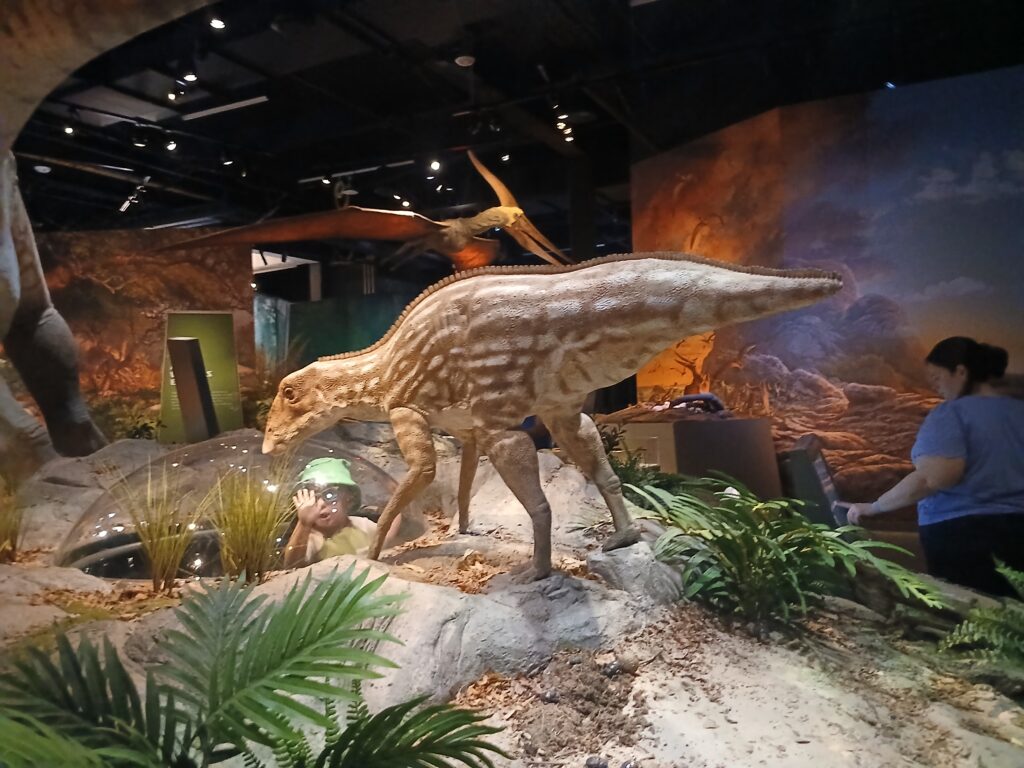
The area is actually richer in marine life, and the entire marine section of the museum is filled with items found on this site. That’s why it’s called a fossil museum, and not a dinosaur museum. But also dinosaurs make it more interesting to visit, especially for the younger set. And it does help tell the greater story.
That story includes the asteroid that hit Chicxulub Mexico, that caused the dinosaur extinction. And the extinction of 75% of the other animals and plants too.
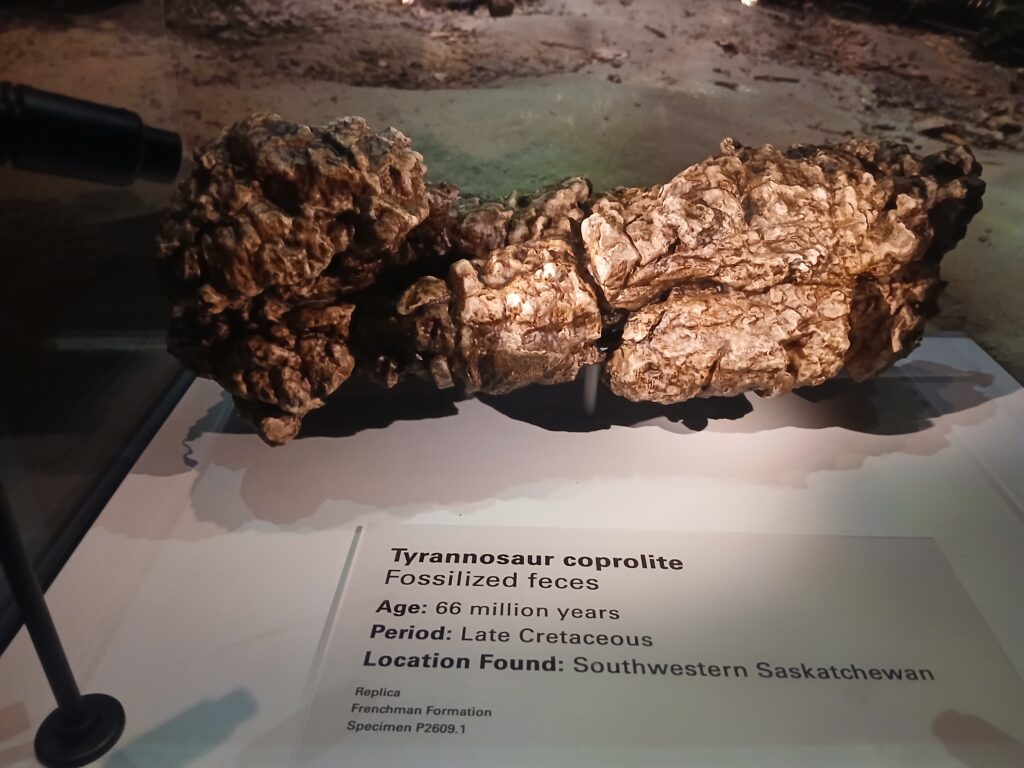
The exhibits were initially conceived for 7-12 year olds, Sena told me. But the museum expanded the vision as planners wanted to show more reality. “Parents would be bored to death,” he told me. And lifelong learners wouldn’t get as much out of it either. Part of that reality is “death cuts,” including a recreated dead dinosaur with a bloody, broken leg. It looked to me like the leg had been sawed in half, and the gore was visible. It was also a bit darker in that section and it was in the back, so perhaps the younger kids may not immediately notice it. Most dinosaurs found have some type of trauma recorded, including stress fractures, the exhibit noted.
You’ll learn (if you don’t already know) that all birds are dinosaurs, but not all dinosaurs are birds. And that feathers evolved from scales.
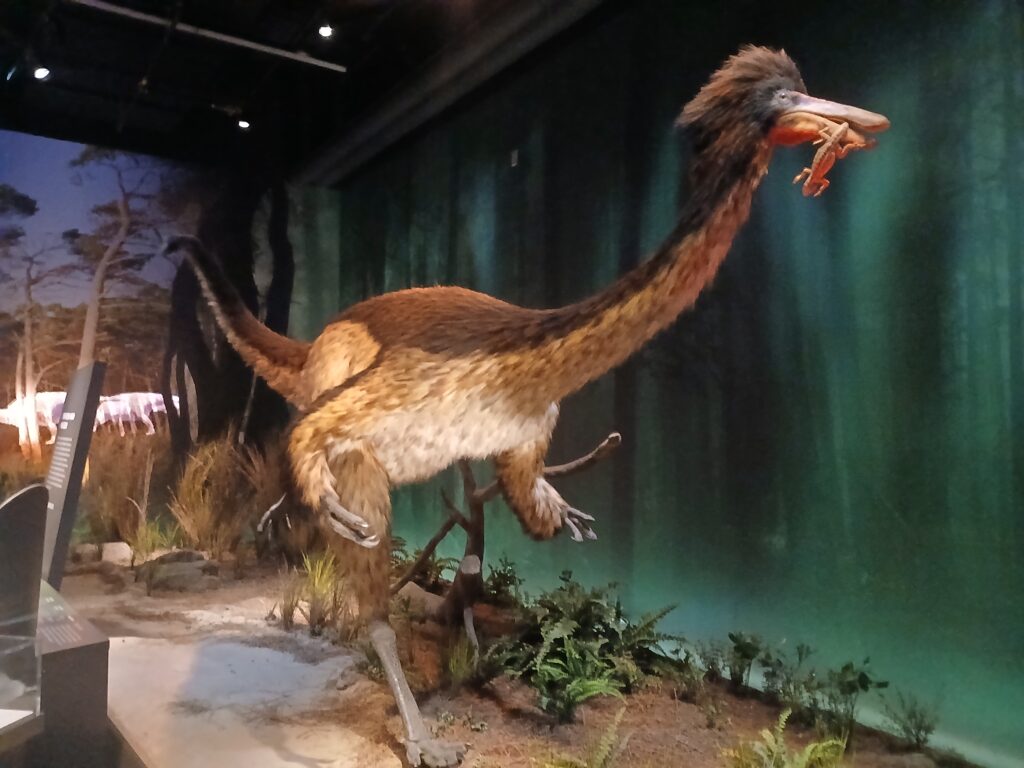
The halls have interactive screens. You receive a card at admission that you scan at each screen to do activities, like learning about how the dark lizards died out and the light-colored lizards lived after a volcanic explosion (or maybe it was the reverse?). Natural selection. And one where you can virtually dust off dirt while “digging” for fossils and see what you find. There were many screens scattered throughout and you can look up what you did when you get home, and bring your card back the next time too. Your name comes up on the screen when you scan it.

The dinosaur hall and the marine life hall have videos (of a sort) on one wall each, with flying or swimming creatures and sounds as well. You can see the marine one below. While every continent had dinosaurs, the larger the dinosaur, the less likely they are to fossilize. That’s because few geological events can quickly bury a dinosaur. They have more exposure and weathering, plus scavenging. Watery lowland environments are best for fossilization.
That’s why the hadrosaurus is the best known, because they congregate in abundance in the lowlands. They are the best preserved group of dinosaurs, with paleontologists finding bones, skin, teeth, eggs, embryos, gut contents and footprints. They’ve also been able to preserve blood vessels, bone cells and proteins, which is giving scientists new information on a molecular level.
The toddlers will love learning about Mabel the Mammal in dioramas at their level. I did not get down on my knees to look in those, nor to crawl through the tunnel into the pop-up bubble to immerse myself in the dino exhibit, but you and your kids are welcome to do that.
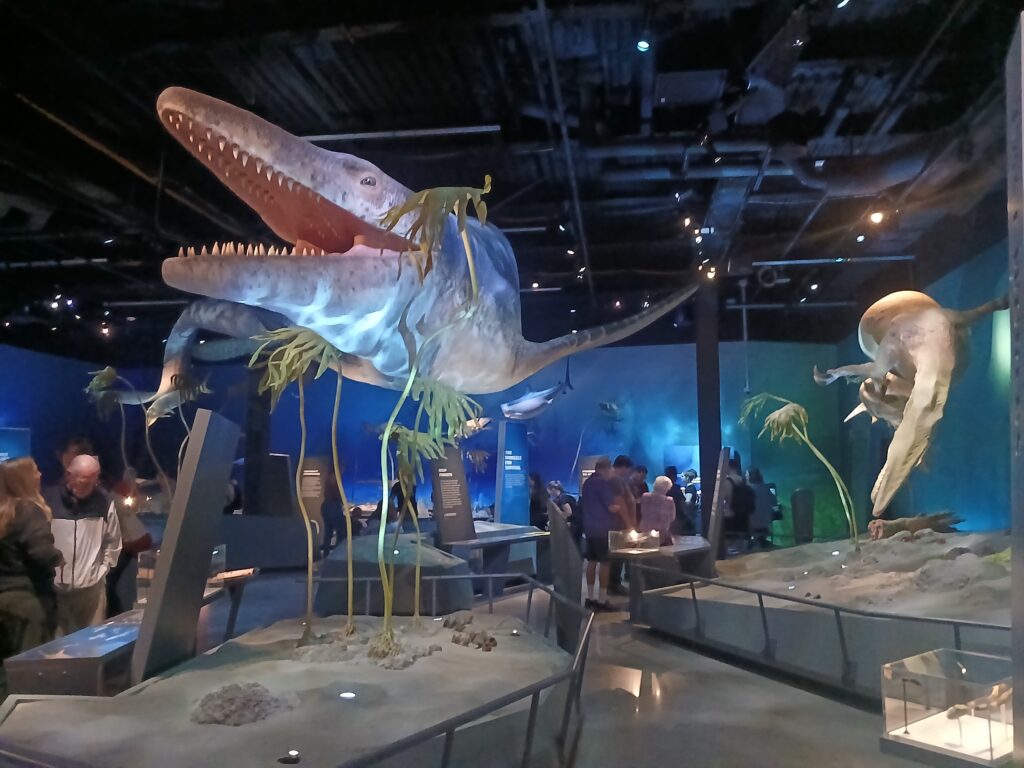
The focal point of the marine life room is the 55-foot long mosasaur, which could turn its tail into a C, and then straighten it out to zoom from 0-33 MPH in less than one second. Impressive! You can see fossils found on site, from turtle bones to shells to eagle rays to sea snails. And marine life poop.
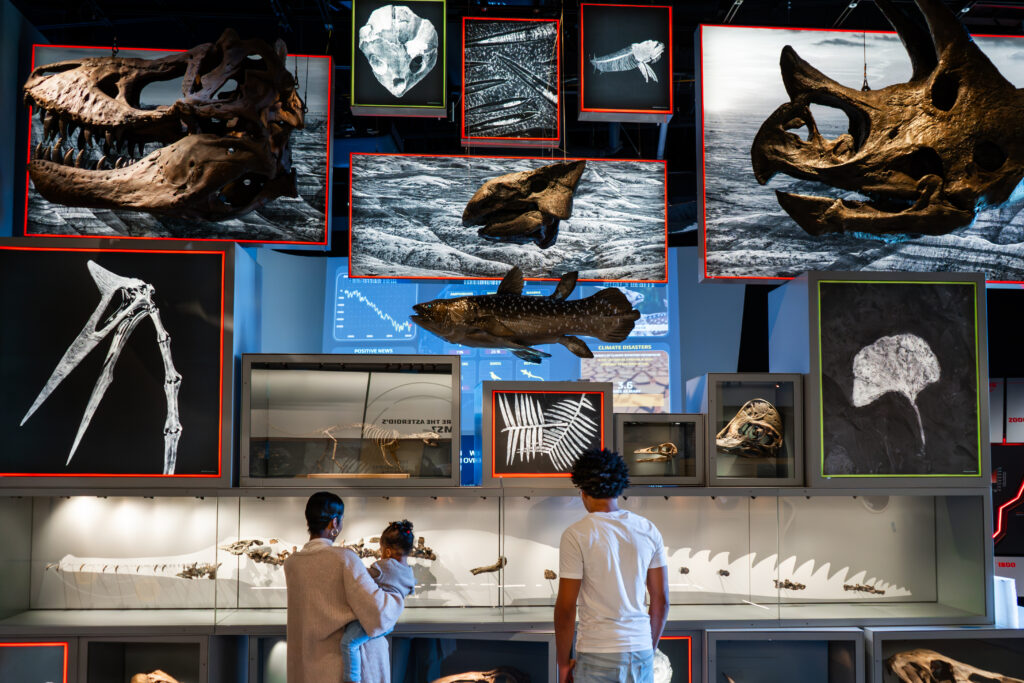
The Hall of Extinction was my favorite part of the museum, as it dove into the asteroid event 66 million years ago that caused the extinction event. A city-sized asteroid hit Mexico (offshore) leading to an earthquake, hot air blast, a 140-foot tsunami, and temperatures rising on Earth to about 700 degrees. Trees fell, vegetation caught fire, and small rocks and sticks became shrapnel. According to the exhibit, every dinosaur that wasn’t a bird died, and the blast debris went up as high as the moon and potentially to Mars. The crater was 110 miles wide and 12 miles deep.
Edelman has the most “bodily remains” – fossils of creatures that died in that blast. There are 3 debris types in this main fossil layer, including shocked quartz (concussed grains of rock from Mexico), glass spherules (cooled bits of molten rock ejected from the impact) and iridium dust from the asteroid.
Southern New Jersey had no hard rock outcrops, and the geology was composed of layers of sediment first laid down by waters (sea, and later rivers/streams). The only animals surviving were smaller than a badger. Given the heat and the dust/ash that rose for about a decade, the temperatures dropped without the sunlight access and photosynthesis was minimal. This led to starvation and ocean extinction as well.
The asteroid theory became widely accepted in the last few decades, and research has shown the K-pg boundary (Cretaceous–Paleogene) in various parts of the world – the dividing line between these two eras. This Mantua site has the greatest number and diversity of fossils from that time.
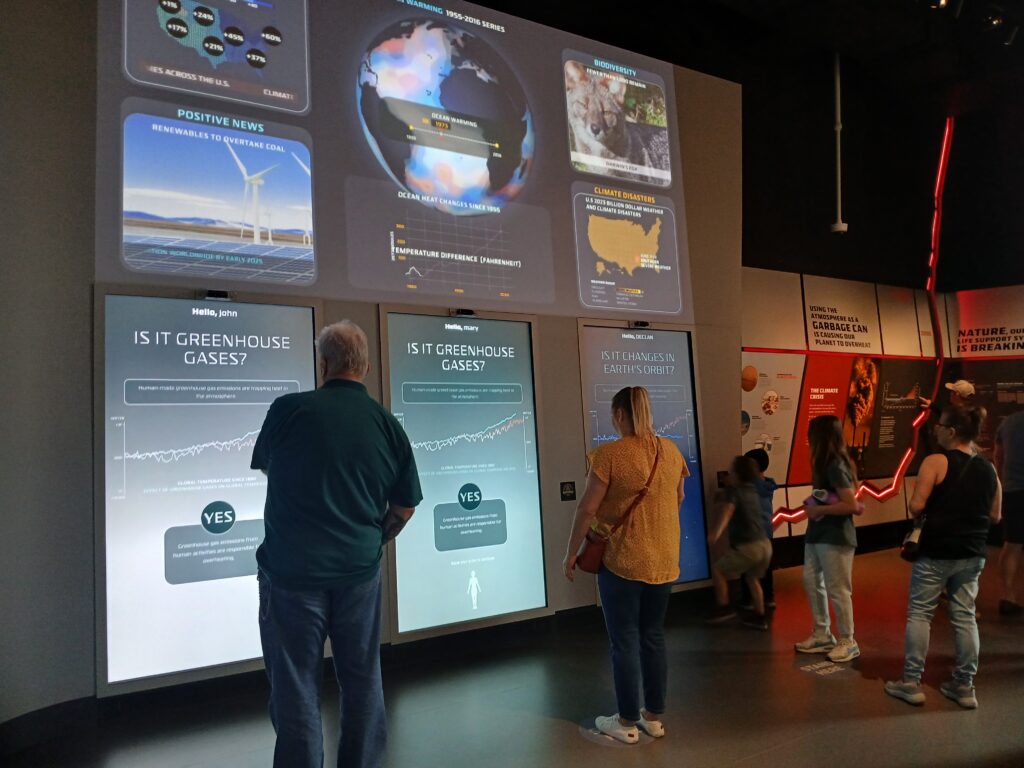
Sena told me that the last exhibit on the main floor, about the sixth extinction (happening now!) has been the most impactful for the younger crowd. Here you’ll learn about how the Earth is losing 1 species every 13 minutes or 1 a day, depending on which studies you follow. There is plenty to explore in this small gallery, including these adult-size interactive screens operated by moving your arms. There are also actionable ideas shared on how kids can help protect the planet.

Heading downstairs, there is more to do. The Collections and Conservation room will at times host paleontologists and students doing their work. The glass wall allows people to watch without getting into the space. When no one is working there, the staff moves exhibits up to the window for more teaching opportunities. During the school year, there will be more to see live here.
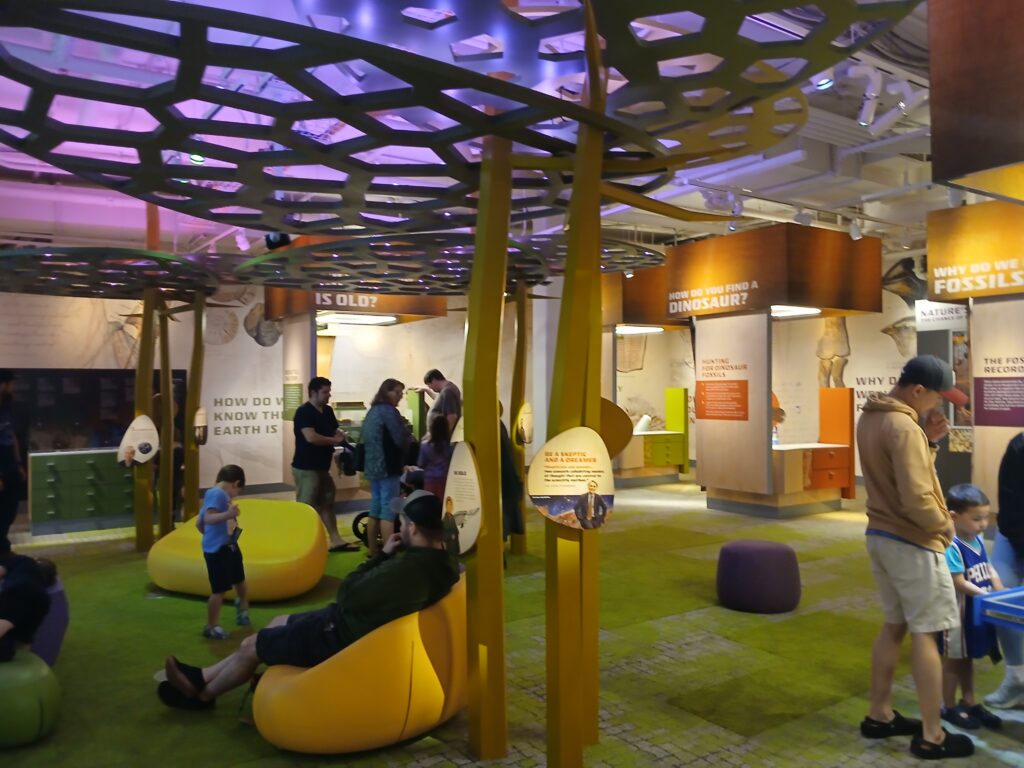
The Discovery Forest is intended for the younger kids, but there’s a lot to learn in here as well, for people who are curious. Grab a seat and watch an ongoing movie on the big wall, or pull out drawers in each station to see what’s in them. They have themes like: How to find a dinosaur, chances of fossilizaiton, why things evolve, and how to read the rocks. I learned a lot, even though I felt a bit like the creepy adult in the room without a kid with me.
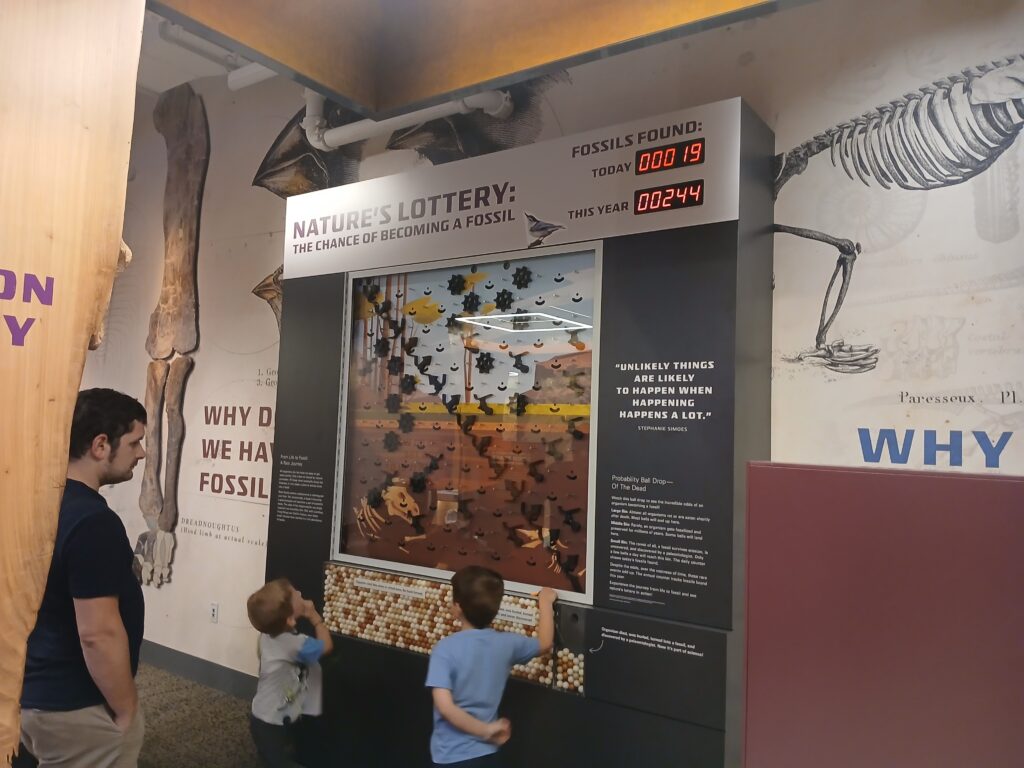
Here I learned about how the East Coast has a lot of sedimentary deposits of the right age (237 to 66 million years ago) to find a dinosaur. But unlike Montana or Patagonia, the rocks here are not well exposed, making it more difficult. In the desert and badlands, they are more exposed. Mostly the dinos here are under flat ground, covered by forest, towns or roads. At Edelman, the sedimentary rock is the right age and exposed in 4 acres.
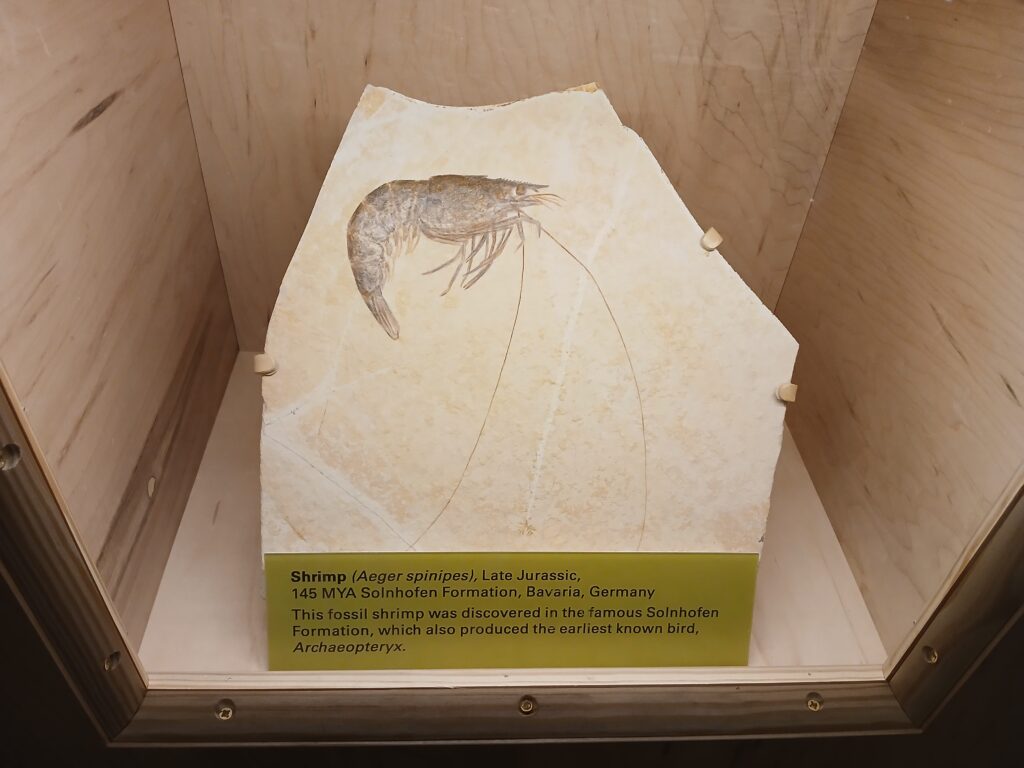
I also learned about Steno’s laws about rock outcropping. Sedimentary rocks are laid horizontally and any tilting happens after the rocks solidify. If you see similar sequence layers of rock on opposite sides of a valley or canyon, it means the layers were once connected.
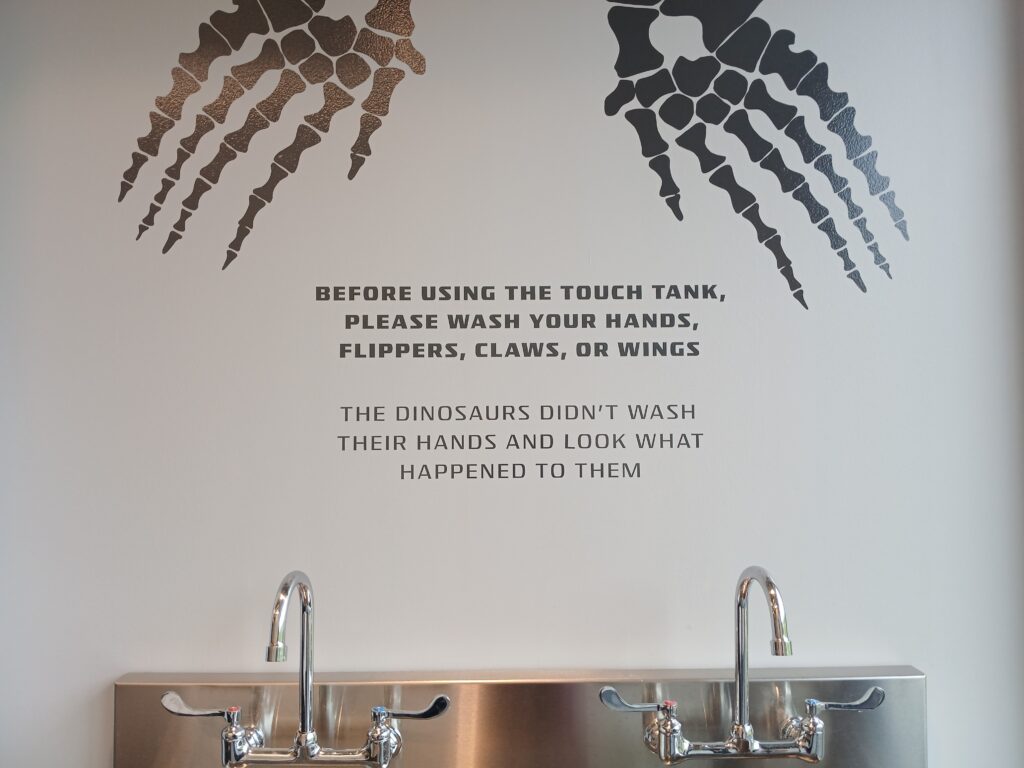
The Critter Cove is evolving and not fully open yet (though you can go inside). They have a turtle, monitor lizard and rat exhibits coming, but the animals are getting used to their environment in the museum, and aren’t ready for display.

The touch tank has animals in it already, which you can see, but they are also acclimating before being ready for handling. A fish tank, below, has a list of what’s in there so you can try to find everything.
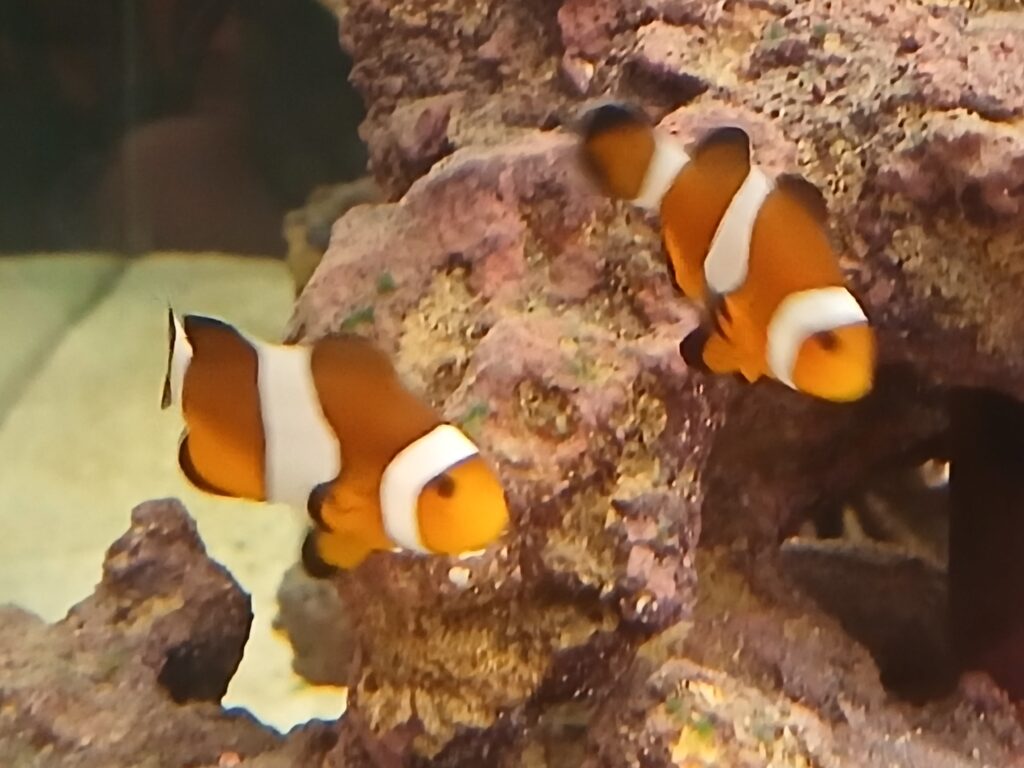
For the older kids (56 inches and higher), try out the virtual reality experience which takes you into the Cretaceous landscape with the dinosaurs for 15 minutes of adventure and fact finding. That exhibit costs extra and you should sign up in advance because it can sell out (as it did the weekend I visited). This is a VR experience where you get to walk around – you’re not stuck in a chair.
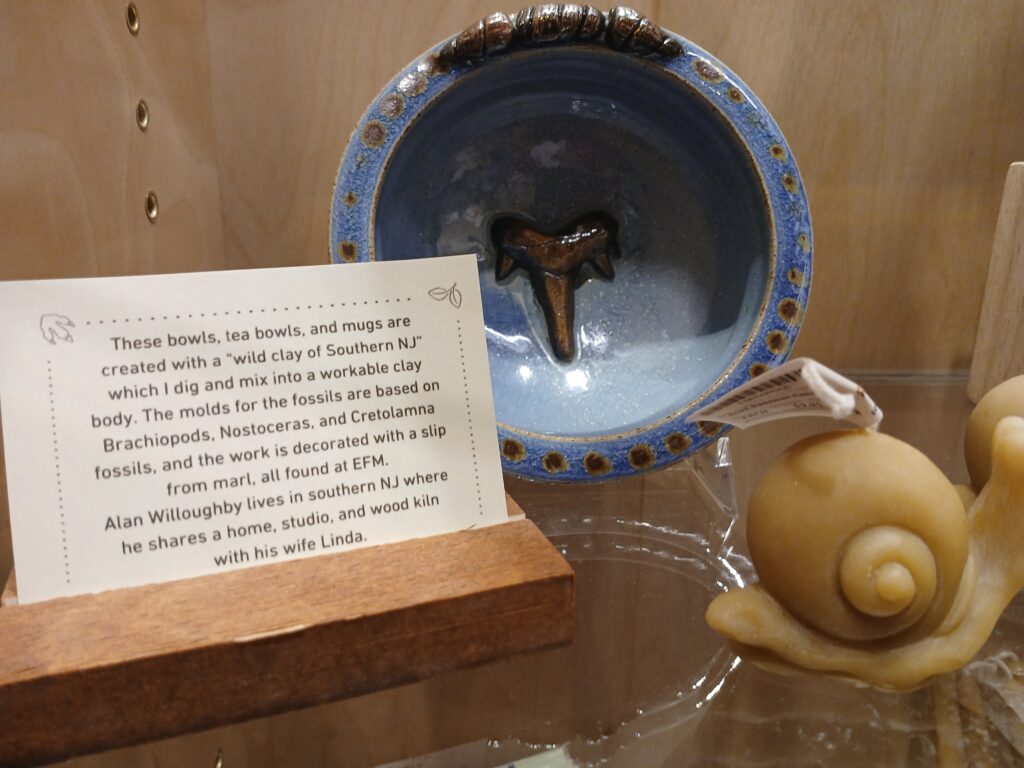
I love a good museum gift shop, and this one does not disappoint. Lots of locally made things like the pottery from Southern NJ clay and artists, and the candles made locally as well.
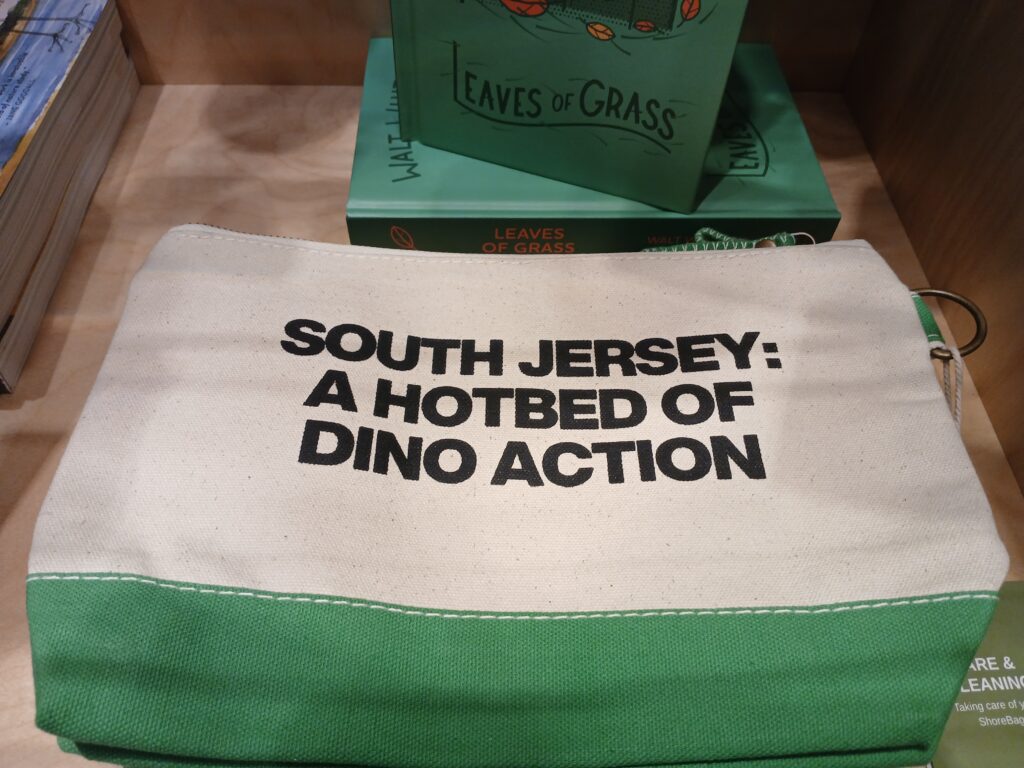
The Charles Darwin study, with two rooms of reading materials and nooks (along with a crawl space to get into another part of the gift shop) was adorable. And I love that you can spend time in there reading.
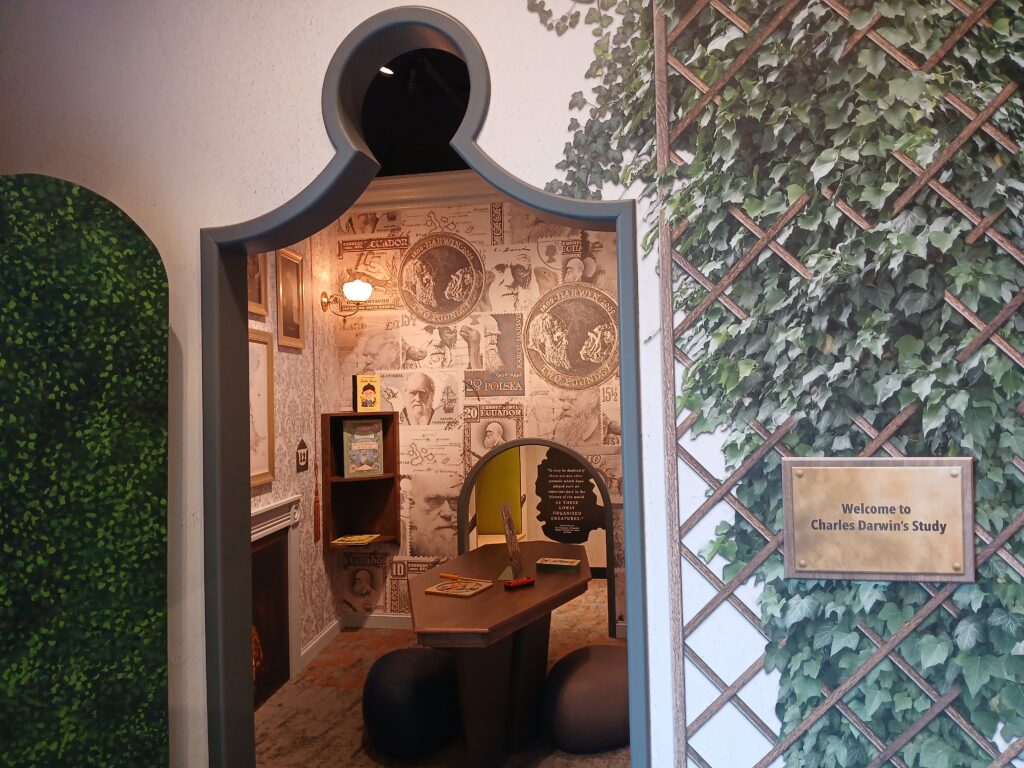
From the museum front hallway, you can can exit to a patio overlooking the marl pit which now holds the quarry dig experience. Currently you need to visit the museum if you want to do this add-on $25 experience, though in the future, you can do it separately for $40. The 75-minute experience includes a short video explaining the importance of the site and how the dig works. As you walk down this pathway from the entrance to the pit, every step represents 400,000 years in time. You can look into tunnels which point to different strata levels and layers of sediment, so you can see what’s in them.
The pond you see on the other side of the museum is what happens when the water isn’t pumped out of the sand pit. There’s a pumphouse not pictured below, that must be continually pumping out water. It extracts about 150,000 gallons daily, filtering it through an underground limestone bed before it goes back to nature.
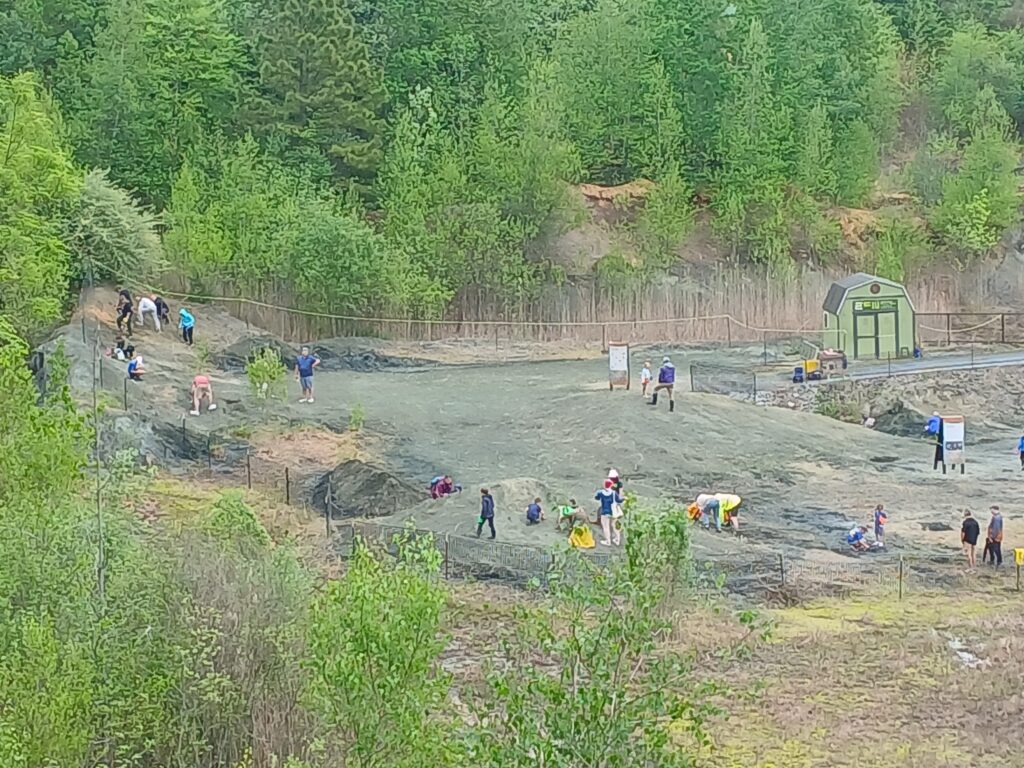
You have about 30 minutes to dig (rain or shine, (though if it’s unsafe, they’ll call it off). You’ll use plastic shovels and sifters. After that, you’ll bring everything back up to the gatehouse and clean the items off, identifying them (rocks? fossils?). You’re allowed to bring home 3 fossils. Any extras will be used on-site for demonstration, to give to people who didn’t find anything, or seeded in the table for those who are unable to physically go to the dig site.
Sena told me that if you actively dig, you’re almost guaranteed to find something – usually shells or sponges. If you’re lucky, a shark tooth. Lots of kids, though, just like to run around and therefore they may not find anything on their own. About 30-50 people can do the dig at any given time, and it can sell out. So plan ahead. The cost is on top of a museum ticket.
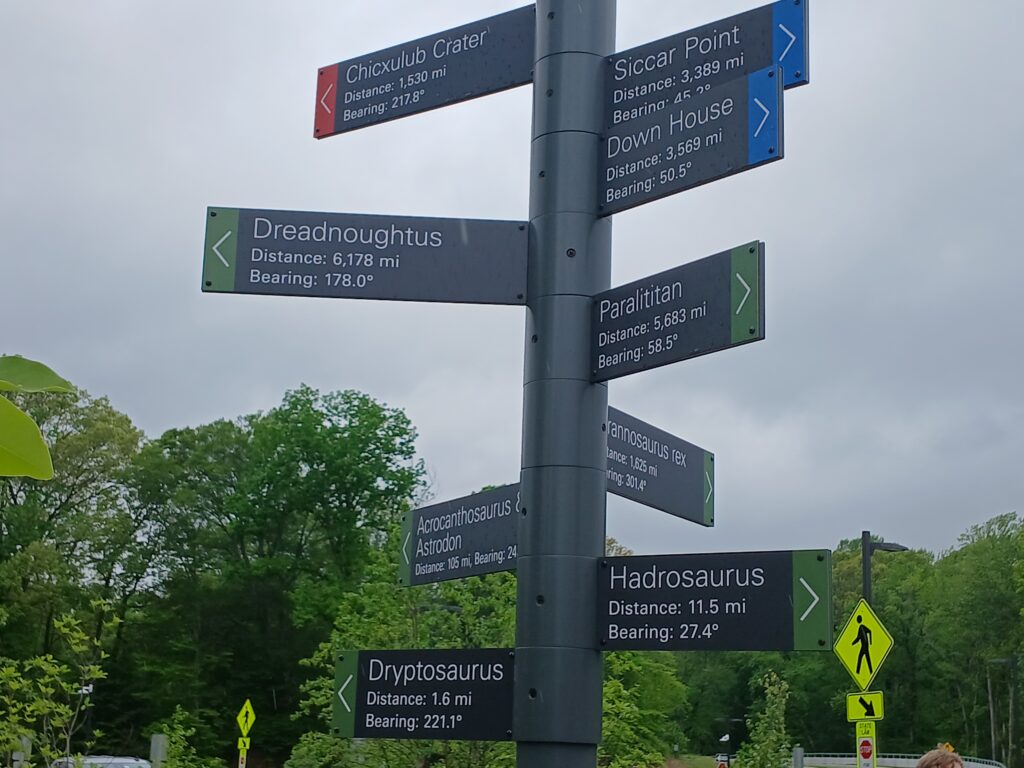
The playground is open to the public at no cost and is busy all the time, Sena said. The pteradon (pictured) is not actually a dinosaur, but a flying reptile. There are nature trails behind this playground – about 1.2 miles into the forest. It was raining when I visited, so I did not hike.
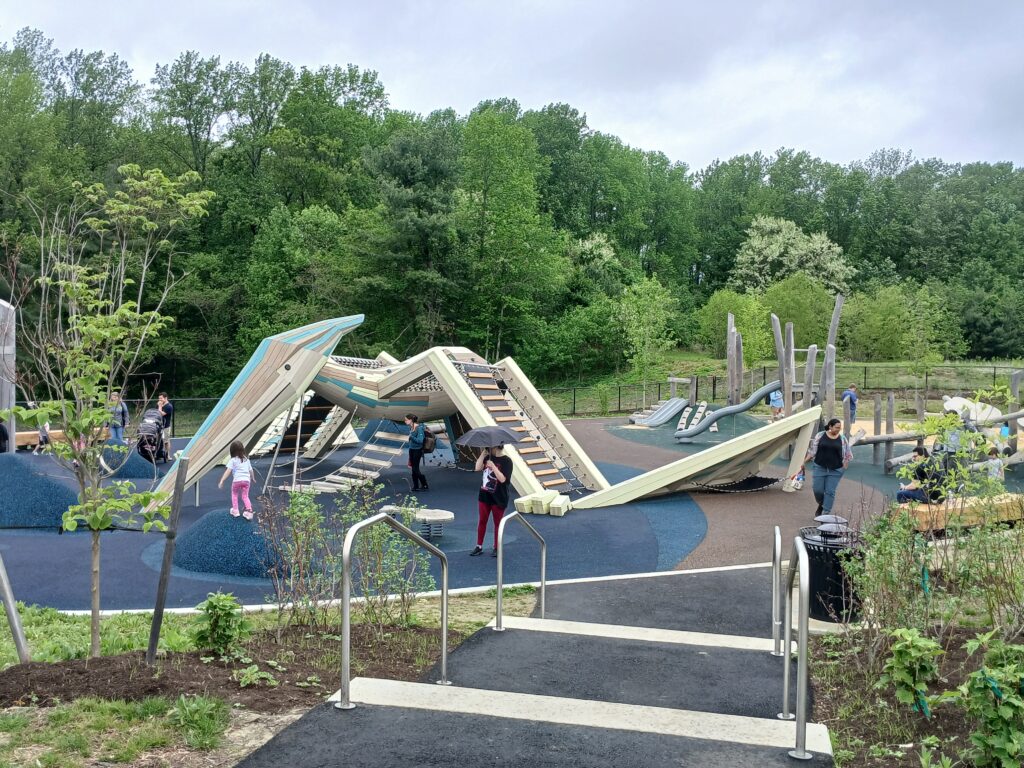
The exterior is landscaped nicely with plants that have been identified to be native to the area and similar to what existed in the Cretaceous period. They worked with a Penn biologist to find 38 of these plants and planted 27 of them. They will grow in and are adjacent to the main building.
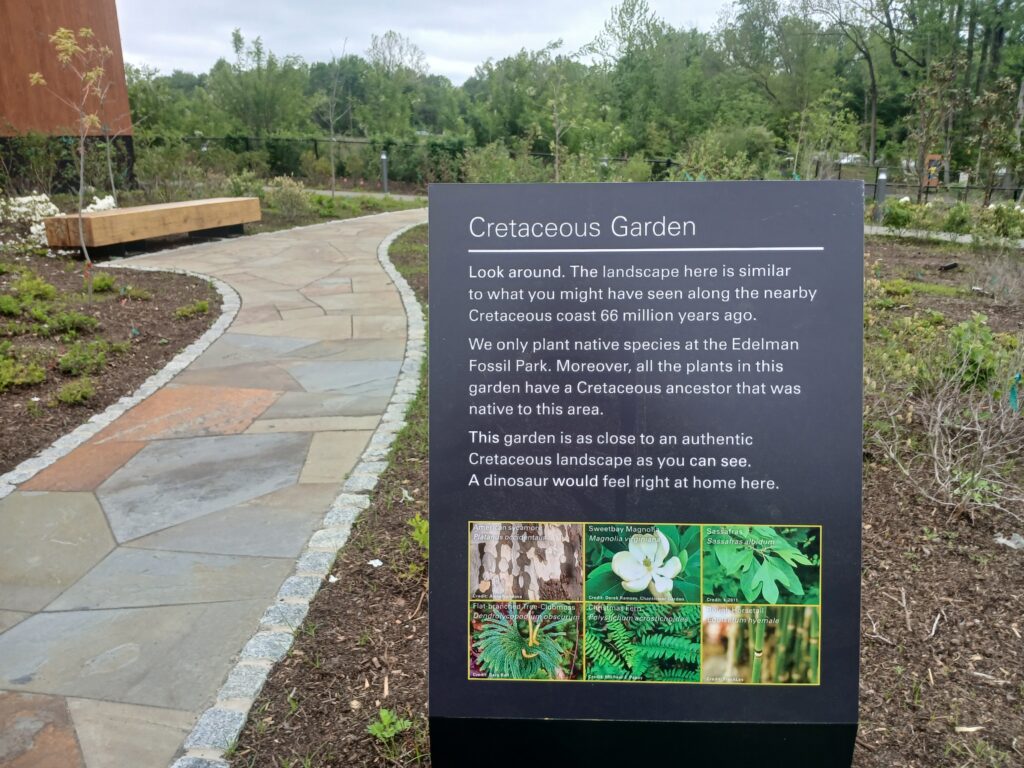
If you go to the Edelman Fossil Museum with kids
They recommend you buy timed tickets. That’s because it can sell out. They do track how many people are inside at any given time. It can be a pricey trip, especially with add-ons.
Tickets: $29 for 13+; $24 for 3-12, and free for 2 and under. There is an additional fee for buying tickets online (around $2).
Quarry dig: $25
Virtual reality: $25
Food: They have a lovely cafe with food and drinks, and both an indoor and outdoor area to eat and relax.
Museum members receive discounts for everything.
